The Naxi Lifeworld: Native Painters in Northwestern Yunnan
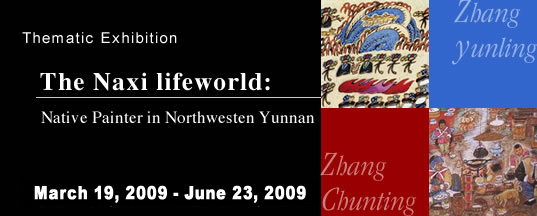
 A happy time in winter by Zhang Yunling |

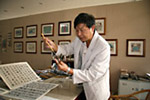
Zhang Yunling
ZHANG Yunling was born in Lijiang Naxi Autonomous County of Yunnan Province in 1955. He now works as associate professor at the Yunnan Nationalities Museum in Kunming. He is a member of the Chinese Artists’ Association. In 1975, he entered Yunnan Art College where he was instructed by Prof. Lang at the Department of Fine Arts. Upon graduation in 1980, he returned to his hometown and started working in the Mass Art and Culture Institute of Lijiang. There he studied traditional Naxi Dongba art and culture and especially the folk paintings. This led to his own style of painting using Dongba pictographs as basic elements. In 1986 his paintings were exhibited at the Yunnan Art Exhibition in France by the Yunnan International Culture Exchange Center. In 1988 the exhibition, Naxi People Zhang Yunling’s Contemporary Naxi Dongba Paintings, was held during the 1st Yunnan Folk Art Festival in Kunming. Zhang Yunling held exhibitions in Tokyo and Seoul in 1990. He began working at the Yunnan Nationalities Museum in 1995. He submitted a paper to the International Workshop of Formative Arts and held an exhibition in Jinju, Korea in 2001. He attended the activities for celebrating the 35th anniversary of the normalization of diplomatic relations between Japan and China and held an exhibition in Osaka in 2002. In 2003, a series of exhibitions was held across the USA while he was staying at Whiteman College in Washington State as a visiting professor.
ZHANG Yunling was born in Lijiang Naxi Autonomous County of Yunnan Province in 1955. He now works as associate professor at the Yunnan Nationalities Museum in Kunming. He is a member of the Chinese Artists’ Association. In 1975, he entered Yunnan Art College where he was instructed by Prof. Lang at the Department of Fine Arts. Upon graduation in 1980, he returned to his hometown and started working in the Mass Art and Culture Institute of Lijiang. There he studied traditional Naxi Dongba art and culture and especially the folk paintings. This led to his own style of painting using Dongba pictographs as basic elements. In 1986 his paintings were exhibited at the Yunnan Art Exhibition in France by the Yunnan International Culture Exchange Center. In 1988 the exhibition, Naxi People Zhang Yunling’s Contemporary Naxi Dongba Paintings, was held during the 1st Yunnan Folk Art Festival in Kunming. Zhang Yunling held exhibitions in Tokyo and Seoul in 1990. He began working at the Yunnan Nationalities Museum in 1995. He submitted a paper to the International Workshop of Formative Arts and held an exhibition in Jinju, Korea in 2001. He attended the activities for celebrating the 35th anniversary of the normalization of diplomatic relations between Japan and China and held an exhibition in Osaka in 2002. In 2003, a series of exhibitions was held across the USA while he was staying at Whiteman College in Washington State as a visiting professor.
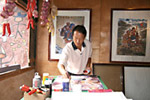
Zhang Chunting
ZHANG Chunting was born in 1958 in a village not far from Shigu town in Lijiang Naxi Autonomous County, Yunnan Province. He is a member of the Chinese Peasants’ Calligraphy and Painting Research Institute and deputy director of the Lijiang Shigu Calligraphy and Painting Association. After graduating from junior high school, he stayed in the village and worked as a farmer. During the Cultural Revolution period, he drew many propaganda paintings for the Communist Youth League of his village. He began working in a movie theater in 1984 and drew movie posters. In 1986 his movie posters received an Excellence Prize from Yunnan Province. He returned to Shigu town in 1990 and drew pictures of his fellow people as a peasant painter. In 1993 he won an Excellence Prize at a peasants’calligraphy and painting exhibition. In 1995 his work, ‘Choosing an auspicious day to change one’s name’, won an Excellence Prize at the First Chinese Peasants’ Calligraphy and Painting Exhibition. In 1999 he contributed to a mural painting of Shangri-la, at Deqing Airport. He also participated in painting scenes for the International Naxi Dongba Culture and Art Festival, and the mural paintings of famous hotels. In 2001, CCTV shot a documentary about him and his work, ‘Zhang Chunting and Gallery in Shigu’.
ZHANG Chunting was born in 1958 in a village not far from Shigu town in Lijiang Naxi Autonomous County, Yunnan Province. He is a member of the Chinese Peasants’ Calligraphy and Painting Research Institute and deputy director of the Lijiang Shigu Calligraphy and Painting Association. After graduating from junior high school, he stayed in the village and worked as a farmer. During the Cultural Revolution period, he drew many propaganda paintings for the Communist Youth League of his village. He began working in a movie theater in 1984 and drew movie posters. In 1986 his movie posters received an Excellence Prize from Yunnan Province. He returned to Shigu town in 1990 and drew pictures of his fellow people as a peasant painter. In 1993 he won an Excellence Prize at a peasants’calligraphy and painting exhibition. In 1995 his work, ‘Choosing an auspicious day to change one’s name’, won an Excellence Prize at the First Chinese Peasants’ Calligraphy and Painting Exhibition. In 1999 he contributed to a mural painting of Shangri-la, at Deqing Airport. He also participated in painting scenes for the International Naxi Dongba Culture and Art Festival, and the mural paintings of famous hotels. In 2001, CCTV shot a documentary about him and his work, ‘Zhang Chunting and Gallery in Shigu’.

|
|
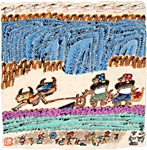 Ploughing and seeding in spring by Zhang Yunling |
|
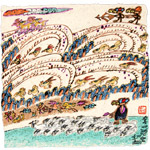 Summer, the season of hunting by Zhang Yunling |
|
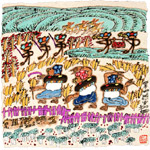 Harvesting in autumn by Zhang Yunling |
|
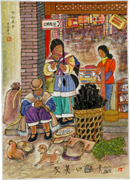 Over the phone, a mother tells her daughter far away, “Study hard” by Zhang Chunting Over the phone, a mother tells her daughter far away, “Study hard” by Zhang Chunting |
|
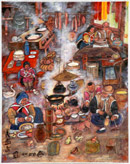 The smell of the kitchen in my childhood by Zhang Chunting |
|
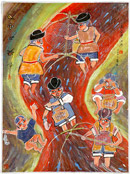 River after a rainfall by Zhang Chunting |
||||
|
|
||||||||
|
|
 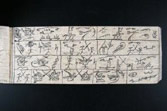 Naxi Dongba manuscripts |
|
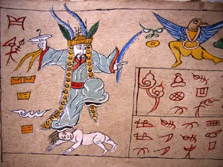 Naxi Dongba manuscripts |
|
|
|
 |
|
 |
|
 |
|
| Naxi priest, Dongba, in Shangri-la County | ||||||
|
|
 |
|
 |
|
 |
|
| Naxi woman in Lijiang Naxi Autonomous County | Naxi people in Shangri-la County | |||||
|
|
 Jade Dragon Snow Mountain in Lijiang |
|
 Jinsha River at Shigu town, the First Bend of the Yangtze River |
|
|
|
|
 A Naxi house in Shangri-la County |
|
 Baishuitai (White Water Terraces) A sacred site in Shangri-la County |
|
|





